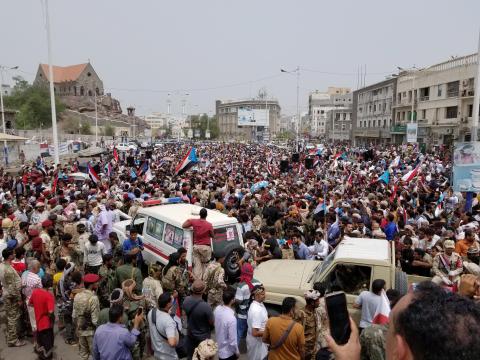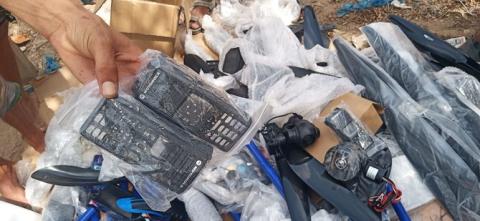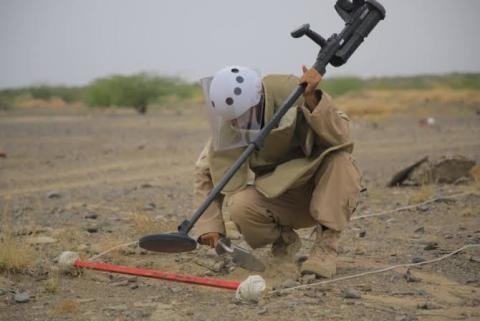Whatever happened to the ceasefire deal in Yemen?


Yemen's warring parties agreed a UN-brokered ceasefire for the Red Sea port city of Hodeidah back in December but, several weeks on, deadlines have come and gone and much of the accord has still not taken hold.
The deal prompted hope that the parties might keep meeting and eventually find a negotiated way out of the war, providing respite to Yemenis, who the UN now says are 'more vulnerable and hungrier than at any time in a conflict marked by repeated warnings of famine.
That there was a deal at all represented progress. There hadn't been much expectation that the Houthi rebels and the internationally recognised (but mostly exiled) government of President Abd-Rabbu Mansour Hadi would find common ground at the talks at a castle outside Stockholm, if their representatives showed up at all.
In the end they did shake hands on although not sign a deal that has become known as the Stockholm Agreement. It included a ceasefire in Hodeidah, a 'mechanism for a prisoner exchange, and a 'statement of understanding on Taiz a city and province that has seen some of the most sustained fighting in a war that has gone on for 46 months and killed tens of thousands of people.
The Hodeidah deal has garnered the most attention, largely because humanitarians have been warning that a battle in the city would be catastrophic for a country that is so dependent on imports especially as the port is in the north, where some 70% of Yemenis live.
The wording of the Stockholm Agreement is vague. That lack of clarity is either a design flaw or a feature, depending who you ask: it has allowed the parties to haggle over details and delay the process, but it may also have been the best that the UN envoy, Martin Griffiths, could get out of two sides who have been fighting each other for years.
Griffiths defended the Hodeidah agreement recently as 'generally holding, saying 'initial timelines were rather ambitious given the 'complex situation on the ground. But with headlines describing the accord as 'shaky, 'fragile, even as 'failing, here's a deeper look at what was agreed, what has happened since, and what to expect.
The first step outlined in the Hodeidah agreement was an immediate ceasefire in the city and around the port of Hodeidah, as well as around two other nearby ports and oil terminals.
While there has been a decrease in fighting and an all-out assault on Hodeidah has been put on pause both sides have accused the other of multiple violations of the ceasefire. A monitoring mission the UN Security Council approved on January 16 is still not fully in place to verify these claims.
Humanitarian sources on the ground told IRIN that while airstrikes on the city have stopped, fighting hasn't decreased enough to allow aid delivery to take place unhindered or to make Hodeidah safe for aid workers or civilians.
'So far the agreement hasn't translated to the level of access and impact that we would want in terms of addressing the massive needs, not just in Hodeidah, but across other parts of the country. The World Food Programme says it hasn't been able to assess the damage to grain silos reportedly hit by shelling at the port earlier this month or to get to the location of those stores since September.
Karl Schembri, regional media adviser for the Norwegian Refugee Council (NRC), told IRIN from Hodeidah that services in the city are still very limited and that the main hospital is damaged and inaccessible because it is on a front line.
'Electricity is only commercially available and very expensive, he said. 'Medical facilities are basic; some hospitals can deal with minor surgeries.
The next step in the agreement is a 'mutual redeployment of forces from the area, with security in the city becoming the responsibility of 'local security forces.
However, the sides disagree on who those 'local security forces should be. Griffiths and his team have been shuttling between countries and capitals since the December handshake trying to find common ground on this and other points of contention.
The withdrawal, which hasn't happened yet, has been overseen by a UN-chaired Redeployment Co-ordination Committee set up by Dutch general Patrick Cammaert. The committee has so far met only three times, most recently on a ship moored off the Red Sea neutral territory.
Danish general Michael Anker Lollesgaard is now set to take over from Cammaert, who the UN says only planned to be in the post for one month. Further steps are envisaged under the Hodeidah agreement, but full redeployment which was supposed to happen within 21 days is the hurdle that needs to be crossed first.
Sultana Begum, advocacy manager for the NRC in Yemen, said there needed to be a lot more progress on the ground despite a 'glimmer of hope in the past few days, including the meeting on the boat.
'The political talks have yet to deliver, Begum said.
AFP.

Yemeni officials on Monday condemned arrests and prosecutions by the Iran-backed Houthi militia directed against media, journalists and celebrities…

Yemen's warring parties are gearing up for new waves of conflict in 2023 amid a lack of decisive steps towards sustainable peace, adding to the suf…

The UAE will help to recruit doctors and deliver crucial supplies for hospitals in Yemen under a major healthcare drive. The Khalifa bin…